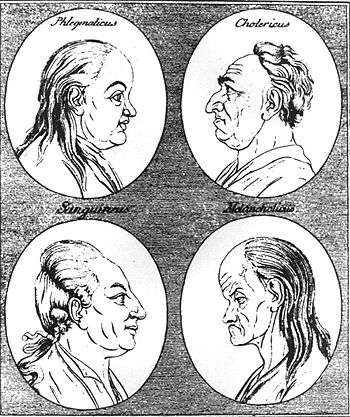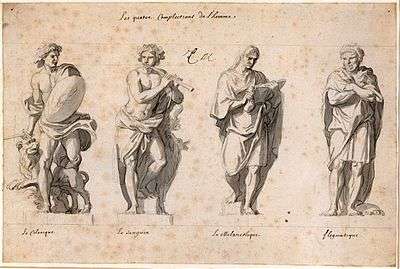Four temperaments
The four temperament theory is a proto-psychological theory which suggests that there are four fundamental personality types: sanguine, choleric, melancholic, and phlegmatic.[2][3] Most formulations include the possibility of mixtures among the types where an individual's personality types overlap and they share two or more temperaments. Greek physician Hippocrates (c. 460 – c. 370 BC) described the four temperaments as part of the ancient medical concept of humourism, that four bodily fluids affect human personality traits and behaviours. Modern medical science does not define a fixed relationship between internal secretions and personality, although some psychological personality type systems use categories similar to the Greek temperaments.

History and development
Temperament theory has its roots in the ancient theory of humourism. It may have originated in Ancient Egyptian medicine[4] or in Mesopotamia,[5] but it was Greek physician Hippocrates (460–370 BC) who developed it into a medical theory. He believed that certain human moods, emotions, and behaviours were caused by an excess or lack of body fluids (called "humours"), which he classified as blood, yellow bile, black bile, and phlegm.[3] Galen (AD 129 – c. 200) developed the first typology of temperament in his dissertation De temperamentis, and searched for physiological reasons for different behaviours in humans. He classified them as hot/cold and dry/wet taken from the four elements.[6] There could also be "balance" between the qualities, yielding a total of nine temperaments. The word "temperament" itself comes from Latin "temperare", "to mix". In the ideal personality, the complementary characteristics were exquisitely balanced among warm-cool and dry-moist. In four less-ideal types, one of the four qualities was dominant over all the others. In the remaining four types, one pair of qualities dominated the complementary pair; for example, warm and moist dominated cool and dry. These last four were the temperamental categories which Galen named "sanguine", "choleric", "melancholic", and "phlegmatic" after the bodily humours. Each was the result of an excess of one of the humours which produced the imbalance in paired qualities.[3][7][8][9]

Persian polymath Avicenna (980–1037 AD) extended the theory of temperaments in his Canon of Medicine, which was a standard medical text at many medieval universities. He applied them to "emotional aspects, mental capacity, moral attitudes, self-awareness, movements and dreams."[10] Nicholas Culpeper (1616–1654) suggested that the humors acted as governing principles in bodily health, with astrological correspondences,[11] and explained their influence upon physiognomy and personality.[12] He proposed that some people had a single temperament, while others had an admixture of two, a primary and secondary temperament.[13]
Modern medical science has rejected the theories of the four temperaments, though their use persists as a metaphor within certain psychological fields.[14] Immanuel Kant (1724–1804), Rudolf Steiner (1861–1925), Alfred Adler (1879–1937), Erich Adickes (1866–1925), Eduard Spranger (1914), Ernst Kretschmer (1920), and Erich Fromm (1947) all theorised on the four temperaments (with different names) and greatly shaped modern theories of temperament. Hans Eysenck (1916–1997) was one of the first psychologists to analyse personality differences using a psycho-statistical method called factor analysis, and his research led him to believe that temperament is biologically based. The factors that he proposed in his book Dimensions of Personality were neuroticism (N), the tendency to experience negative emotions, and extraversion (E), the tendency to enjoy positive events, especially social ones. By pairing the two dimensions, Eysenck noted how the results were similar to the four ancient temperaments.
Other researchers developed similar systems, many of which did not use the ancient temperament names, and several paired extraversion with a different factor which would determine relationship and task-orientation. Examples are DiSC assessment, social styles, and a theory that adds a fifth temperament. One of the most popular today is the Keirsey Temperament Sorter, whose four temperaments were based largely on the Greek gods Apollo, Dionysus, Epimetheus, and Prometheus, and were mapped to the 16 types of the Myers–Briggs Type Indicator (MBTI). They were renamed as Artisan (SP), Guardian (SJ), Idealist (NF), and Rational (NT).
| Classical | Element | Adler[15] | Blood Type[16] | Riemann[17] | DISC[18] |
|---|---|---|---|---|---|
| Melancholic | Earth | Avoiding | A | Obsessive | Compliance |
| Phlegmatic | Water | Getting | AB | Schizoid | Submission |
| Sanguine | Air | Socially useful | B | Hysterical | Inducement |
| Choleric | Fire | Ruling | O | Depressed | Dominance |
Four fundamental personality types
Most individuals tend to have aspects of their personality which identify with each of the four temperaments. However, there are usually one or two primary temperaments that are displayed at a significantly higher level. An individual could be any combination of the following four types.
Sanguine personality type is described primarily as being highly talkative, enthusiastic, active, and social. Sanguines tend to be more extroverted and enjoy being part of a crowd; they find that being social, outgoing, and charismatic is easy to accomplish.[2][3] Individuals with this personality have a hard time doing nothing and engage in more risk seeking behavior.[2]
Choleric individuals tend to be more extroverted. They are described as independent, decisive, goal-oriented, and ambitious. These combined with their dominant, result-oriented outlook make them natural leaders. In Greek, Medieval, and Renaissance thought, they were also violent, vengeful, and short-tempered.[19]
Melancholic individuals tend to be analytical and detail-oriented, and they are deep thinkers and feelers. They are introverted and try to avoid being singled out in a crowd.[2] A melancholic personality leads to self-reliant individuals who are thoughtful, reserved, and often anxious.[2] They often strive for perfection within themselves and their surroundings, which leads to tidy and detail-oriented behavior.[2]
Phlegmatic individuals tend to be relaxed, peaceful, quiet, and easy-going.[2] They are sympathetic and care about others, yet they try to hide their emotions. Phlegmatic individuals are also good at generalising ideas or problems to the world and making compromises.[2]
Modern views, implementations and restatements
Waldorf education and anthroposophy believe that the temperaments help to understand personality. Christian writer Tim LaHaye has attempted to repopularize the ancient temperaments through his books.[20][21][22] Carl Philipp Emanuel Bach composed the trio sonata in C minor “Sanguineus et Melancholicus“ Wq 161/1. Émile Zola employed the four temperaments in Thérèse Raquin.[23] Carl Nielsen's Symphony No. 2 (Op.16) is titled and structured upon "The Four Temperaments."[24]
The four temperaments have also been picked up by management training and consulting firms as a way of helping people to understand their colleagues. The Colour Works organisation, for example, runs a course focusing on the four temperaments as their core product[25]. In order to modernise the system, and to distinguish it from the historical system of Hippocrates, they have renamed the temperaments after colours. Red is choleric, green phlegmatic, yellow sanguine, and blue melancholic. These follow from the nature of the temperament associated with the colour they have chosen, and also correspond to the elements associated with each type, as per the colour correspondences normally chosen by people to represent them in fiction and elsewhere[26].
See also
- Big Five personality traits
- Enneagram of Personality
- Fundamental Interpersonal Relations Orientation
- Myers-Briggs Type Indicator
- Table of similar systems of comparison of temperaments
- Two-factor models of personality.
References
- Woodcut from Johann Kaspar Lavater, Physiognomische Fragmente zur Beförderung der Menschenkenntnis und Menschenliebe (1775–1778)
- "The Four Human Temperaments". www.thetransformedsoul.com.
- Merenda, P. F. (1987). "Toward a Four-Factor Theory of Temperament and/or Personality". Journal of Personality Assessment. 51 (3): 367–374. doi:10.1207/s15327752jpa5103_4. PMID 16372840.
- van Sertima, Ivan (1992). The Golden Age of the Moor. Transaction Publishers. p. 17. ISBN 1-56000-581-5.
- Sudhoff, Karl (1926). "Essays in the History of Medicine". Medical Life Press, New York: 67, 87, 104. Cite journal requires
|journal=(help) - Boeree, C. George. "Early Medicine and Physiology". Retrieved 21 February 2013.
- Kagan, Jerome (1998). Galen's Prophecy: Temperament In Human Nature. New York: Basic Books. ISBN 0-465-08405-2.
- Osborn L. Ac., David K. "INHERENT TEMPERAMENT". Retrieved 21 February 2013.
- "Archived copy". Archived from the original on 2011-07-20. Retrieved 2010-03-26.CS1 maint: archived copy as title (link)
- Lutz, Peter L. (2002). The Rise of Experimental Biology: An Illustrated History. Humana Press. p. 60. ISBN 0-89603-835-1.
- Nicholas Culpeper (1653) An Astrologo-Physical Discourse of the Human Virtues in the Body of Man, transcribed and annotated by Deborah Houlding. Skyscript, 2009 (retrieved 16 November 2011). Originally published in Culpeper's Complete Herbal (English Physician). London: Peter Cole, 1652.
- Nicholas Culpeper, Semeiotica Urania, or Astrological Judgement of Diseases. London: 1655. Reprint, Nottingham: Ascella, 1994.
- Greenbaum, Dorian Gieseler (2005). Temperament: Astrology's Forgotten Key. Wessex Astrologer. pp. 42, 91. ISBN 1-902405-17-X.
- Martindale, Anne E.; Martindale, Colin (1988). "Metaphorical equivalence of elements and temperaments: Empirical studies of Bachelard's theory of imagination". Journal of Personality and Social Psychology. 55 (5): 836. doi:10.1037/0022-3514.55.5.836.
- Lundin, Robert W. (1989). Alfred-Adler's Basic Concepts and Implications. Taylor and Francis. p. 54. ISBN 0-915202-83-2.
- Kanazawa, Masayuki (2018). Blood Type and Personality 3.0. CreateSpace Independent Publishing Platform. ISBN 1986623815.
- Riemann, Fritz (2008). Anxiety. Reinhardt Ernst. ISBN 978-3-497-02043-0.
- Marston, William (2015). Emotions of Normal People - Scholar's Choice Edition. Creative Media Partners. ISBN 1298026717.
- "The Four Humours".
- LaHaye, Tim (1966). The Spirit Controlled Temperament. Tyndale Publishing.
- LaHaye, Tim (1984). Your Temperament: Discover Its Potential. Tyndale Publishing. ISBN 0-8423-6220-7.
- LaHaye, Tim (1988). Why You Act the Way You Do. Tyndale Publishing. ISBN 0-8423-8212-7.
- Zola, Preface to Thérèse Raquin.
- Foltmann, Niels Bo, ed. (1998). Symphony No. 2 (PDF). Carl Nielsen Works. II. Instrumental Music. 2. The Carl Nielsen Edition, Royal Danish Library. ISBN 978-87-598-0913-6. ISMN M-66134-000-3. Archived (PDF) from the original on 16 October 2014.
- https://www.thecolourworks.com/insights-discovery-colour-types-guide/
- https://tvtropes.org/pmwiki/pmwiki.php/Main/ColorCodedElements
Further reading
- Edelman, Kathleen (2019). I Said This, You Heard That: How Your Wiring Colors Your Communication. North Point Resources. ISBN 978-1943535415
- Arikha, Noga (2007). Passions and Tempers: A History of the Humours. Harpers. ISBN 978-0060731175
External links
- In Our Time (BBC Radio 4) episode on the four humours in MP3 format, 45 minutes
- I Said This, You Heard That (A Group Study in the Four Temperaments) interactive workbook format that includes a temperament assessment; accompanying teaching videos available through the free app.